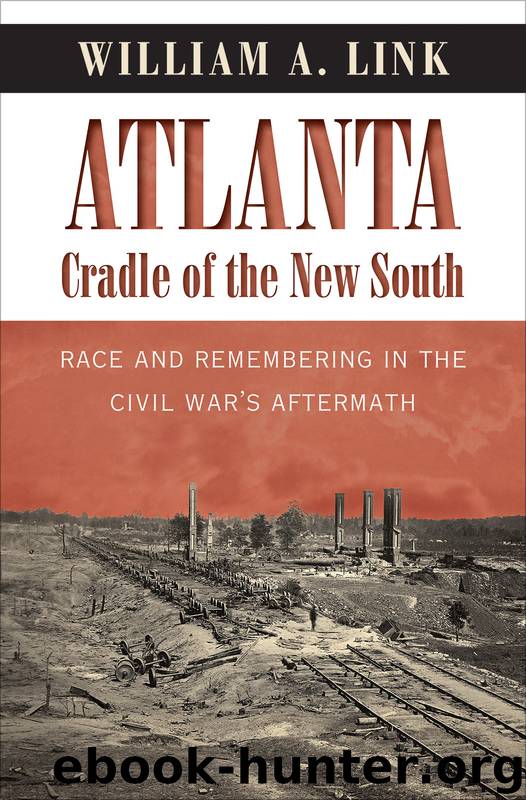Atlanta, Cradle of the New South by William A. Link

Author:William A. Link
Language: eng
Format: epub
Publisher: The University of North Carolina Press
Published: 2013-03-21T16:00:00+00:00
Horace Bumstead (courtesy of the Atlanta University Center)
Soon after he arrived on campus in the late 1860s, a black student met Ware. He was different from other whites, the student noticed, in the way in which he treated black people and extended common courtesies. “It was a new and strange thing to us to see a white man carrying wood and making fires for us, who had been taught, by precept and example, that it was our business to do the like for his kind.”75 “However you may be mistreated in the city or elsewhere,” Ware was said to have informed students, “I want you to know that the moment you set foot on these grounds you are free men in a free country.” When a white Atlantan asked him how he could live with black people, Ware responded: “Oh, I can easily explain that; I’m simply color blind.”76
The early generation of Atlanta University students was especially aware of its role in the emancipated South. Ware’s aim, along with that of the abolitionist educators, was to empower the students through education. “How I wish you could have been with us last Tuesday morning, as scholars and teachers marched a few yards, to observe the ceremony of breaking ground for the new building,” a white observer wrote in May 1870. The school’s students processed to the building site, their faces “beaming with joy and hope.” Between the two new buildings were the remains of Confederate earthworks, still surviving six years after the Atlanta Campaign. The moment was not lost on J. W. Alvord, the Freedmen’s Bureau general superintendent of education. “I look out upon these entrenchments,” he wrote, “in wonder at the change which four short years have made.” The Confederate fortifications had “defied the approach of freedom”; in their place stood “walls of brick and stone to shelter the children of the free, and endow them with the power of knowledge.” “The roar of batteries,” Alvord wrote, was now “exchanged for the music of school songs and recitations.”77
At the ceremony, Ware read the proclamation of the Fifteenth Amendment, which provided voting rights for black males and was ratified in February 1870. The 100th Psalm was read aloud, and the audience sang Julia Ward Howe’s “Battle Hymn of the Republic.” “From those hearts,” read the account, “there went up a united prayer of gratitude that our country was now not only free in name but in very deed, and that God had answered [our] prayer, in regard to the success of our schools, not according to our faith, but much surpassing it.” God would surely hear the “thanks of His poor, despised people.”78
Ware’s racial egalitarianism shaped his organization of the campus. From the beginning, the university was racially integrated—an exceptional situation in the white supremacist South. The belief in racially integrated education lay at the core of the AMA philosophy. As early as 1866, AMA field secretary Edwin P. Smith planned a school open “to all without distinction of color.” Smith had found that, throughout the South, young black men were “waiting for such an opening.
Download
This site does not store any files on its server. We only index and link to content provided by other sites. Please contact the content providers to delete copyright contents if any and email us, we'll remove relevant links or contents immediately.
| Africa | Americas |
| Arctic & Antarctica | Asia |
| Australia & Oceania | Europe |
| Middle East | Russia |
| United States | World |
| Ancient Civilizations | Military |
| Historical Study & Educational Resources |
Cat's cradle by Kurt Vonnegut(14768)
Pimp by Iceberg Slim(13787)
Underground: A Human History of the Worlds Beneath Our Feet by Will Hunt(11841)
4 3 2 1: A Novel by Paul Auster(11800)
The Radium Girls by Kate Moore(11626)
Wiseguy by Nicholas Pileggi(5323)
American History Stories, Volume III (Yesterday's Classics) by Pratt Mara L(5139)
Perfect Rhythm by Jae(5075)
The Fire Next Time by James Baldwin(5024)
Paper Towns by Green John(4805)
Pale Blue Dot by Carl Sagan(4626)
A Higher Loyalty: Truth, Lies, and Leadership by James Comey(4555)
The Mayflower and the Pilgrims' New World by Nathaniel Philbrick(4285)
The Doomsday Machine by Daniel Ellsberg(4250)
Killers of the Flower Moon: The Osage Murders and the Birth of the FBI by David Grann(4192)
Too Much and Not the Mood by Durga Chew-Bose(4097)
The Sympathizer by Viet Thanh Nguyen(4096)
The Borden Murders by Sarah Miller(4025)
Sticky Fingers by Joe Hagan(3916)
